BY STEVE POND
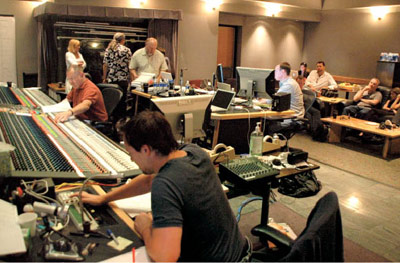 MAKING MUSIC: David Fincher (TOP, left) and his composer Alexandre Desplat wanted
MAKING MUSIC: David Fincher (TOP, left) and his composer Alexandre Desplat wanted
a score that could evoke the period and create the mood for Benjamin Button.Deep on the Sony Pictures lot in Culver City, David Fincher sits on a black leather couch and listens to music. The room, the Streisand Scoring Stage, is huge, with a long mixing board positioned beneath a massive bank of speakers, a separate console loaded with computers and monitors, and an entire wall covered floor-to-ceiling in recording equipment. In the back are a couple of chairs, a coffee table, and the long couch where Fincher is at work.
About 15 people wander in and out; some take seats behind the mixing board and computer monitors, while others hang out in the rear of the room at a craft service buffet. And behind a window at one end of the room, the 87 members of the Hollywood Studio Symphony sit beneath a huge movie screen, as composer and conductor Alexandre Desplat leads them through sections of his score to The Curious Case of Benjamin Button.
Fincher, who was nominated for a DGA Award this year, leans forward as Desplat conducts the music to one of the opening scenes in Benjamin Button, a short story about a man who grows younger as he ages. In the scene, Benjamin's father takes his first look at his newborn son, who is born with the countenance of an old man. Horrified, the father snatches his son and runs into the crowded streets. Desplat's music starts out spare and elegiac, but picks up in tempo and intensity as the action accelerates.
Desplat runs through the music twice, then comes into the control room and says he prefers the second take. Fincher nodded. "It was more mysterious," he says. "You can't go wrong with mysterious."
For most of the afternoon, Desplat recorded bits and pieces, and Fincher nodded his approval. "My main job is to sit back, listen and say 'That's great,'" he joked, but the director did make suggestions: he asked for a subdued piano-and-harp passage to be played even quieter, requested that a final note be drawn out until the film's star, Brad Pitt, walked out of the frame, and even spotted an out-of-tune instrument at one point. ("I was just guessing," he confessed.)
At one point the musicians took a short break, then returned to their seats and began to tune up. Fincher looked up from the couch as they hit a long, low note. "That's good," he said to stage recordist Adam Michalak. "I could use more of that. Can they do it about 10 seconds longer?"
The tuning, Fincher decided, was just the right thing to play over the opening logos that begin the film—but since it was co-produced by Warner Bros. and Paramount, he needed time to show both the Warners shield and the Paramount mountain.
"I like the idea of using the tuning over the logos," explained Fincher. "It's like saying to the audience, 'Sit down, settle in and shut the hell up.'"
In Benjamin Button, Fincher used music to set the film's location in New Orleans, music to evoke the period (which ranges from around 1910 to Hurricane Katrina), music to underscore the emotion, and even music to tell the audience to shut up. A director whose early work includes videos for the likes of Madonna, Sting and The Rolling Stones, he began creating a musical soundtrack and fitting it to the movie more than a year before he and Desplat ever set foot on the Streisand stage, and continued long after the last note (or the last bit of tuning) was recorded.
"You're taking an audience and asking them to sit in a dark room and turn themselves over to you, so the audio environment that you create is as important as the visual environment," Fincher says of his approach to a movie's soundtrack. "You're taking responsibility for everything they see and hear, which includes not only the picture, but your sound, your music, your Foley, your effects, your ambiences, and all the subconscious things you're doing."
On Benjamin Button, Fincher and his longtime sound designer Ren Klyce began by assembling a long list of possible songs to use as source music, from Louis Armstrong's "Dear Old Southland" to the Beatles' version of "Twist and Shout." When the list was eventually sent to the studio to secure clearances, songs that the director was particularly fond of were conspicuously labeled "Fincher Favorite," as a way to make sure the businesspeople tried particularly hard to obtain those rights.
One of the most crucial musical passages in the film, meanwhile, was a piano piece taught to a young Benjamin Button. "I thought a ragtime piece might be nice," says Klyce, "but obviously it would have to be modified and simplified—first, so that it would be believable that Benjamin Button would be able to play it, and second, so that Brad Pitt could learn it." They eventually chose a Scott Joplin waltz called "Bethena," a song Klyce loved since childhood. "Then I slowed it down and simplified the music, how a child would play the piano. And in slowing down that piece of music, it created this really cool, atmospheric, kind of spooky vibe."
Originally, the idea was to tie that piano piece into the score, for which Fincher turned to the French-born Desplat, a 2007 Oscar nominee for The Queen. "Most of the scores I've used previous to Benjamin Button have probably been more like washes, or tonal backdrops," Fincher says. "This time I wanted something different. Themes, reiterations of melodies, setting stuff up and paying it off—those weren't things my previous scores ever did, but I needed them here."
Which is not to say that Fincher wanted to use the score in the way he often heard it used onscreen. "I like the idea of music supporting what you're seeing onscreen," he says. "I don't like the idea of music leading it, or icing it or gilding it. I don't like music telling you 'here's the nice person, and here's the bad person, and here's a cute moment, and here's a joke!'"
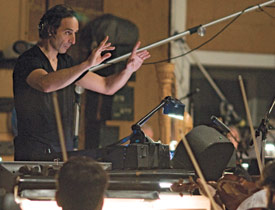 SIGHT AND SOUND: Desplat recording the score.
SIGHT AND SOUND: Desplat recording the score.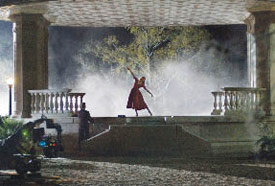 The gazebo scene from the film.
The gazebo scene from the film.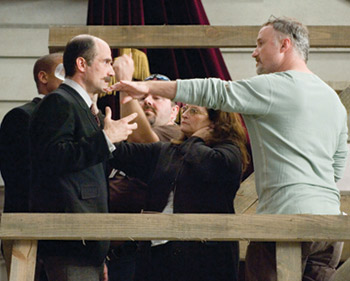 Fincher directing.
Fincher directing.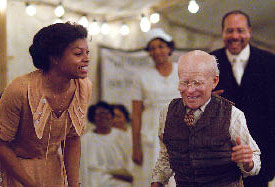 Brad Pitt as Benjamin Button.
Brad Pitt as Benjamin Button.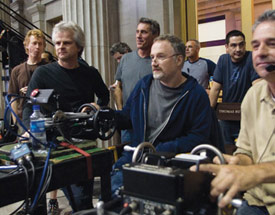 Fincher and crew on the set.
Fincher and crew on the set.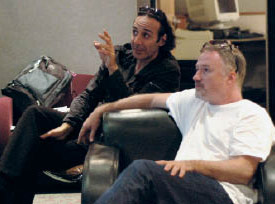 Desplat and Fincher on the soundstage.
Desplat and Fincher on the soundstage.Desplat, whose philosophy is that a film score has to have both "the function and the fiction," saw a cut of the film and met with Fincher in late 2007. "It's always a little bit like two dogs sniffing each other when you first meet the director," says Desplat, who loved the footage he saw. Fincher says that the composer won him over not just with his track record, but also with his personality. "The nice thing was to find that we had a similar sense of humor," he says. "Alexandre didn't take himself too seriously, which is one of the things I might have worried about."
As part of the process of making sure that Desplat's music would fit the film, Klyce prepared a new edit that replaced the original temp music—which had come from a variety of sources, from ambient musician Roger Eno to the Ennio Morricone score to Days of Heaven—with a temp score made up entirely of Desplat's music, drawn from such scores as The Queen, The Painted Veil and Syriana.
"When you hear temp music and it's not yours, you go, 'Oh, I don't like this,' or 'I love that, how can I do as good?'" says Desplat. "Both options cause problems, because you can't copy a master that you like, and you can't copy something you don't like." A film temped with your own music, he adds, is tricky because composers don't want to repeat themselves, but at the same time, it can provide direction. "You hear what they like of your own style, and you try to build around that. That's the seed, and you try to invent a new flower from that seed."
Over a period of months, Desplat wrote music and sent it to Fincher. The initial plan to play off the Scott Joplin variation as Benjamin Button's theme didn't work out, but Button's theme, one of the hardest pieces of music to settle on, did wind up being largely a piano cue. The director, meanwhile, tried to guide the composer, even though he felt as if he simply didn't have the vocabulary to express himself.
"Even when I was making music videos, I was terrible at describing music or telling musicians what I wanted," says Fincher. "Sometimes I'd play something for Alexandre and say, 'I really like this cue because it's so sad,' and he'd say, 'That wasn't supposed to be sad at all!'"
Desplat, though, says he responded to Fincher's approach. "The way that he would explain it was always very deep," he says. "He would talk about the theme, and explain to me how it goes from this character to this one, where it was going in the next scene, and why there should not be too much this or less of that."
For Klyce, the interaction was fascinating. "I come from a musical background and I can speak the language," he says, "and my first instinct is to think that if you're not from a musical background, you're not knowledgeable. But what I've come to realize is that people who don't come from a musical background are sometimes the best people to try to describe music, because they're coming 100 percent from an emotional perspective. David describes music in a way that's narrative, and that's ultimately what it's all about."
Because the movie deals with the passage of time, Desplat tried to incorporate that into his music. Though the score is often spare and transparent—chamber music often dominated by piano and harp, with the backing of an 80-piece orchestra—it is constantly driven by a pulse. "A little motor is in almost every cue, moving along and driving us," says Desplat. He also worked on coming up with themes that could be played backwards and forwards, though he knows most viewers won't notice.
Recording took place for two weeks on the Sony lot, with Fincher in attendance for at least part of each day. Then Klyce took the score to Skywalker Sound in Northern California to work on the final mix of the film, which combined the score with source music, sound effects, dialogue and a voiceover from Pitt.
For the most part, that mix was undertaken with Klyce at Skywalker, and Fincher back in his office in Hollywood. When the sound team would finish a new sequence, they'd turn it into a QuickTime file and send it to Fincher via the Internet. The director, using the PIX system, would be able to write his notes on specific frames, and then send them back to Skywalker.
"It's a very efficient way of working," says Klyce. "If you were sitting next to us, our work would be like watching paint dry. And we're tuned in on minutiae. But when David comes in, his perspective is so fresh that he can see the forest for the trees. We get really good notes, proper notes, rather than technical notes that can bog you down."
For Fincher, the working relationship with Klyce, which began in the early 1980s when they were two of the youngest employees of director John Korty, has grown. "I think it started as a healthy collaboration, and has evolved, at least from my standpoint, into a crippling co-dependency," Fincher jokes.
The two don't always agree—and while Fincher has a reputation as a demanding, painstaking taskmaster, Klyce says the director is hands-on but open to input. For example, Klyce lobbied to change Fincher's mind about the music for a scene in which Cate Blanchett's character, Daisy, dances for Benjamin at an outdoor gazebo.
"Originally I thought, she's a ballet dancer, so she can dance even if there's no music," says Fincher. "I figured we'd either have the scene without music, or Alexandre would write something. But Ren was insistent that she should be dancing to something she was hearing offscreen—that somewhere music was playing, and she heard it and that's what she was dancing to. I didn't think we needed it, but he brought in an old Louis Armstrong song, and it was perfect."
It wasn't the only moment when ideas changed. An idyllic sequence that follows the first time Benjamin and Daisy make love was particularly troublesome. It was initially temped with past Desplat music; then set to a Simon and Garfunkel tune after Fincher's friend, director Spike Jonze, saw it and insisted that it needed a pop song; then rescored by Desplat. Fincher explored ideas for the scene until the last minute, before opting for Desplat's original music.
And the opening pre-credits sequence of the film—the "fable" of a clockmaker who creates a clock that runs backwards—underwent significant revisions after the score was recorded. "It's a sequence that doesn't initially seem to connect to anything else in the movie, and it doesn't pay off until literally the final shot in the film," says Fincher. "But the melody line in Alexandre's music resolved itself, which made the audience view it as a self-contained piece. So we took out the main melody and just kept the rhythm, the timekeeping part, so that it would reinforce that things were unresolved." Fincher knew that the edited sequence might work with musical edits—"We could have just pulled out some instruments and made the music sparser"—but opted to have Desplat write and record a new version instead.
In the end, the film's 13 Oscar nominations included nods to Desplat for original score, and to Klyce for sound mixing. The goal of the soundtrack collaboration, though, wasn't to win nominations, but to use audio—whether it be original music, old songs, sound effects or ambient noise—to advance the narrative and, in Fincher's words, "to work hand-in-glove" with his visuals. If there's a Holy Grail in the process, it's what Fincher calls "the Universal Sync"—that instant when image and sound mesh to create an unexpected, magical moment that wouldn't have been possible otherwise. "My responsibility is to the story," Fincher said simply—and often as not, that story can't fully be told without a complete melding of both sight and sound.